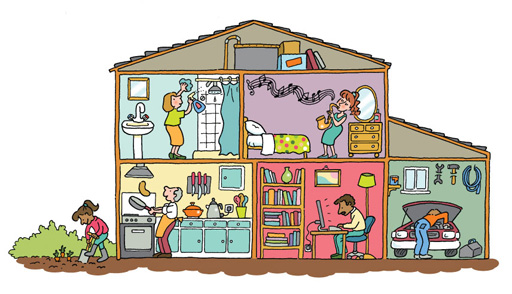2.2 Service improvement and public value
Now that you have considered how public value can contribute to thinking and action about management priorities and adapting to change, you can now explore how you and your immediate colleagues function as a kind of small organisation in itself. The wider system you may be part of has charged you with getting certain things done and, to an extent, it is up to you to work together with others to achieve this. This is where you as a leader can often exert influence. The question of public value outcomes will help you to check that your own unit connects to wider outcomes.In the healthcare system, for example, Mohr et al. (2004) use the term ‘microsystem’ to refer to this smaller unit, and they argue that it provides a conceptual and practical framework for approaching change and innovation. The concept can be used to understand any public service. So who exactly is in your ‘microsystem’ and what do you have to deliver?
Service microsystems
The idea of a service microsystem stems from the work of Quinn (1992), who examined a range of successful service organisations such as restaurant chains, courier organisations and high street retailers. Service quality in these organisations was related to how they structured and supported their front-line service delivery. It was the way that these front-line staff worked with customers that really made the difference, and this was shaped by the techniques and approaches they had to hand, as well as by their training and attitude. What made these organisations excellent and successful was in the way they got these ‘service microsystems’ to work.
Mohr et al. (2004) took the idea of the service microsystem and used it in the public sector to examine how clinical microsystems, responsible for delivering a particular kind of service to a particular group of patients, function and how staff can improve the way the microsystem works together. In what follows, the same basic idea is extended to look also at how any kind of microsystem providing a public service might operate.
A place to be busy
Thinking about public services as being made up of service microsystems is rather like becoming aware that different rooms in a house allow people to be immersed in different things. Yet what goes on in each room contributes to the life of the house. A complex human endeavour like policing, healthcare, or fire and rescue services becomes more comprehensible and manageable for the people involved if different aspects of it take place in separate ‘rooms’ or microsystems.
By dividing large systems into smaller specialised units, it may be easier to relate to a manageable set of tasks and to colleagues. Leaders can then set about trying to make things work better within the boundary of their microsystem, on the assumption that other microsystems are making similar efforts to improve what they are doing, without having to understand too much about what they do.
The microsystem concept focuses our attention on how our local service-providing unit can give us a sense of belonging and a manageable scope for our collective effort with colleagues. It challenges us to think of ways of improving the interconnected human activities involved in the microsystem.
In addition to its use by Quinn (1992) and Mohr et al. (2004), the term comes from a much longer-standing twentieth-century tradition of ‘systems thinking’ about human activities (Checkland and Scholes, 1990). This looks at human activities in terms of the functions they fulfil, drawing on ideas from biology and ecology.
Systems thinking encourages us to think of a service microsystem as something that:
- needs to achieve certain overall goals in response to demands placed on it by a wider ‘environment’ of larger organisations
- receives resources from this wider environment and is subject to some external constraints as to how it can use these resources
- has a degree of autonomy as to how activities are conducted and coordinated, so that the system as a whole has the capability to improve what it does and adapt to changing demands placed on it.
In systems thinking, these ideas can also be applied to larger systems of activity containing several microsystems. So it is possible to think of microsystems as enabled and constrained by larger mesosystems (for example, a police service, a hospital trust, a local authority or a civil service department), and these middle-sized systems as in turn enabled and constrained by larger-scale regional or national structures, or macrosystems.

